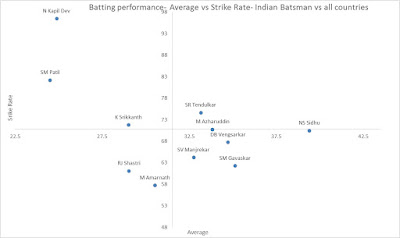The current year’s CK Nayadu
awards have been awarded to Krishnamacharya Srikanth and Anjum Chopra. To a
generation of those began following cricket in the early 1980s, K.Srikanth was
a hero to be emulated of. Flamboyance, instinctive, aggressive, No-tomorrow
attitude endeared to his fans. Till today, Srikanth’s achievements are sort of
discussed in awe. Yet, glance at this statistics reveal otherwise.
He made his debut against England
at home in 1981-82 test series and last played for India in World Cup 1992. His
record as demonstrated by his statistics is pretty ordinary. In his initial
days he was part of the ODI team and could have test place permanent only
around 1985 or so. He scored just two Test hundreds hardly an indication for
cult he seemed to have built.
One day internationals were
different ball game together. They were just getting popular in India in the
early 1980ss. He seemed to be right man for the right format. When he retired
in 1992, her was the highest run getter scoring more than 4000 ODI runs with
four hundreds (a record jointly held with Ravi Shastri). He was the top scorer
in the World Cup final 1983. Yet if we examine his statistics they are pretty
ordinary. He averaged under thirty and had strike rate shade above 70. Not a
great shake by any means even by those standards.
Let us examine his performance
with respect to his peers in India. If we were to plot a graph between batting
average and strike rate, we get an interesting pointers. The first cut off
chosen in March 31, 1992. That was the month which Srikanth played his last one
dayers. All Indian batsmen scoring above 1000 runs are included in the
analysis. It is worthwhile to remember those were the days when not many one
day internationals used to happen. In fact the list comprises only 11 Indian
batsman.
The plot of these 11 batsman is
shown below.
I have sourced the base data from
cricinfo.com
There are quite few run
accumulators (higher average, lower strike rate). A couple of them are laggards
(low average, low strike rate). Few are strikers (high strike rate, low
average. Only one falls under star (high average, high strike rate).
Without doubt, Sachin Tendulkar
was star from the beginning. He maintains high average accompanied by high
strike rate. One should not forget, this was just the beginning of the career
for Sachin. Kapil Dev and Sandeep Patil have high strike rates. K. Srikanth is
on the mean if I have to term so on the strike rate and well below the mean if
we were to build so on the average front.
Not finding a big case for
Srikanth, we will look at the performance of batsman of that era against West
Indies, the giants of the time. Any batsman succeeding against West Indies were
surely the stars. Let us plot the chart for all batsman who have made 500 or
more runs against West Indies in the same time period.
The raw data like before is
sourced from Cricinfo. A couple of surprises already. Imran Khan fits into the
star accompanied by his team mate Javed Miandad. No wonder, that the only team
to give West Indies a run for the money in those days was Pakistan. In the
current instance too Srikanth falls under laggards. He has hardly any inspiring
career against West Indies despite a couple of centuries against them. On the contrary, Allan Lamb’s stardom can
purely explained by his performance against West Indies.
So what explains the stardom of K
Srikanth. The answers could perhaps lie
in the twin concepts of anchoring and availability heuristic. For long Indians
had been used to watch accumulators. Cricketers like Sunil Gavaskar were of the
old school who believed in taming the bowling by wearing the bowlers out. In
contrast Srikanth believed in attacking the bowlers. It was sharp contrast to
watch Srikanth and Gavaskar bat in tandem. It would not be unusual to find
Srikanth racing away to quick fifty while Gavaskar was yet to touch double
figures. Television was getting diffused to larger audiences and to many the mid-1980s
were the first taste of watching live cricket unless you happen to be in test
match venues. Secondly, the sheer image of dominating bowlers throwing all text
book rules into dustbin was something novel. In fact, the first impression of
Srikanth would be his swashbuckling style of striking. In an universe dominated five day test
matches often heading to a draw, this was refreshing. Used to barrage of
bouncers from the quickies, it was something pleasantly different to given West
Indian or Australian bowlers a taste of their medicine. It was offence and not
attrition that mattered for someone like Srikanth He perhaps redefined the art
of batting which was carried forward to greater heights like Sehwag, Yuvraj and
others in the later years. He was the pioneer of hard hitting batsman. His score of 38, the legendary square cut of Andy
Roberts in World Cup final ’83 ( low scoring game), added to the stardom.
In other words, anchored to test
match style, it very different to watch Srikanth and he was the first of the
generation. Whenever one thinks of Srikanth, it is about his carefree batting
style and dominating the bowlers. It did not matter how many runs he scored but
what mattered was how he scored them. This ensued the elevated stardom for
Krishnmacharya Srikanth


Comments
Post a Comment